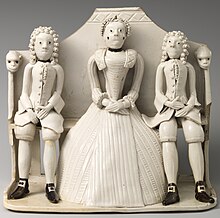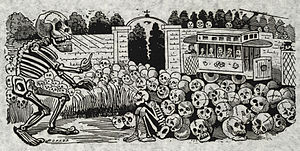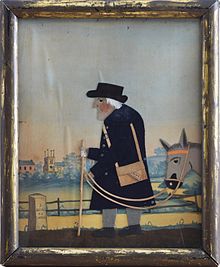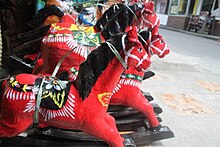நாட்டுப்புறக் கலை




நாட்டுப்புறக் கலை (Folk art) என்பது நாட்டுப்புறக் கலாச்சாரத்தின் சூழலில் உருவாக்கப்பட்ட அனைத்து வகையான காட்சிக் கலைகளையும் உள்ளடக்கியது. ஆனால், வரையறைகள் வேறுபடுகின்றன. பொதுவாக பொருள்கள் பிரத்தியேகமாக அலங்காரமாக இருப்பதை விட ஒருவித நடைமுறை பயன்பாட்டைக் கொண்டுள்ளன. நாட்டுப்புறக் கலையை உருவாக்குபவர்கள் பொதுவாக கலாச்சாரத்தின் நுண்கலை பாரம்பரியத்தை விட பிரபலமான பாரம்பரியத்திற்குள் பயிற்சி பெறுகிறார்கள். நைவ் கலையுடன் பெரும்பாலும் ஒன்றுடன் ஒன்று அல்லது போட்டியிடும் இடமாகவும் உள்ளது. ஆனால் பாரம்பரிய சமூகங்களில் இனவியல் கலை இன்னும் உருவாக்கப்படுகிறது. அந்த சொல் பொதுவாக "நாட்டுப்புற கலை" என்பதற்கு பதிலாக பயன்படுத்தப்படுகிறது.

நாட்டுப்புறக் கலைகள் ஒரு சமூகத்தின் கலாச்சார வாழ்க்கையை வேரூன்றி பிரதிபலிக்கின்றன. அவை நாட்டுப்புற மற்றும் கலாச்சார பாரம்பரியத் துறைகளுடன் தொடர்புடைய வெளிப்பாட்டு கலாச்சாரத்தின் கூறுகளை உள்ளடக்கியது. பொருள்சார் பண்பாட்டுக் கலையில் வரலாற்று ரீதியாக வடிவமைக்கப்பட்ட மற்றும் ஒரு பாரம்பரிய சமூகத்திற்குள் பயன்படுத்தப்படும் பொருட்கள் அடங்கும். அருவமான நாட்டுப்புற கலைகளில் இசை, நடனம் மற்றும் கதை கட்டமைப்புகள் போன்ற வடிவங்கள் அடங்கும்.
நாட்டுப்புற கலைப் பொருட்களின் பண்புகள்
[தொகு]
நாட்டுப்புற கலையின் பொருள்கள் பொருள்சார் கலாச்சாரத்தின் துணைக்குழுவாகும். மேலும் புலன்களின் மூலம் அனுபவிக்கும் பொருள்களைப் பார்க்கவும் தொடுவதன் மூலமும் அடங்கும். அனைத்து பொருள் கலாச்சாரத்தையும் போலவே, இந்த உறுதியான பொருட்களையும் கையாளலாம். மீண்டும் மீண்டும் மாற்றலாம். சில சமயங்களில் உடைக்கலாம். ஏற்கனவே உள்ள வடிவம் மற்றும் வடிவமைப்பின் திறமையான தொழில்நுட்ப செயல்பாட்டின் காரணமாக அவை கலைப் படைப்புகளாகக் கருதப்படுகின்றன; படிவத்தின் துல்லியம், மேற்பரப்பு அலங்காரம் அல்லது முடிக்கப்பட்ட தயாரிப்பின் அழகில் திறன் காணப்படலாம். ஒரு நாட்டுப்புற கலையாக, இந்த பொருள்கள் பொருள்சார் பண்பாட்டின் பிற கலைப்பொருட்களிலிருந்து வேறுபடும் பல பண்புகளைப் பகிர்ந்து கொள்கின்றன.
நாட்டுப்புற கலைஞர்கள்
[தொகு]ஒரு பொருளானது ஒரு கைவினைஞர் அல்லது கைவினைஞர்களின் குழுவால் உருவாக்கப்படுகிறது. கைவினைஞர்களும் பெண்களும் ஒரு நிறுவப்பட்ட கலாச்சார கட்டமைப்பிற்குள் வேலை செய்கிறார்கள். அவற்றை வடிவமைப்பதில் அவர்கள் அடிக்கடி அடையாளம் காணக்கூடிய பாணியையும் முறையையும் கொண்டிருக்கிறார்கள். அவற்றின் தயாரிப்புகளை அங்கீகரிக்கவும் ஒரு தனி நபர் அல்லது பட்டறையைக் காரணமாகவும் கூறுகிறார்கள்.
1894 ஆம் ஆண்டில் வெளியிடப்பட்ட வோல்க்ஸ்கன்ஸ்ட், ஹவுஸ்ஃப்ளீஸ், அண்ட் ஹவுசிந்துஸ்ட்ரி பற்றிய ஆய்வில் அலோயிஸ் ரீகல் என்பவர் இதை முதலில் வெளிப்படுத்தினார். நாட்டுப்புற படைப்பாற்றலில் கூட கலைஞரின் தனிப்பட்ட கை மற்றும் நோக்கங்கள் குறிப்பிடத்தக்கவை என்பதை வலியுறுத்தினார். நிச்சயமாக, கலைஞர்கள் குழு எதிர்பார்ப்புகளால் கடத்தப்பட்ட வடிவங்கள் மற்றும் மரபுகளின் விதிமுறைகளுக்கு உட்பட்டு செயல்பட வேண்டிய கட்டாயத்தில் இருந்திருக்கலாம். ஆனால் தனிப்பட்ட படைப்பாற்றல் - இது தனிப்பட்ட அழகியல் தேர்வுகள் மற்றும் தொழில்நுட்ப திறமை ஆகியவற்றைக் குறிக்கிறது - பெறப்பட்ட அல்லது மரபுரிமையான மரபுகளை தேக்கமடையாமல் காப்பாற்றி அவற்றை புதுப்பிக்க அனுமதித்தது ஒவ்வொரு தலைமுறையிலும்.
தற்காலம்
[தொகு]தற்கால வெளிக் கலைஞர்கள் அடிக்கடி சுயமாகக் கற்பிக்கப்படுகிறார்கள். ஏனெனில் அவர்களின் பணி பெரும்பாலும் தனிமையில் அல்லது நாடு முழுவதும் உள்ள சிறிய சமூகங்களில் உருவாக்கப்படுகிறது. சுமித்சுசேனியன் அமெரிக்கன் கலை அருங்காட்சியகத்தில் இதுபோன்ற 70க்கும் மேற்பட்ட நாட்டுப்புற மற்றும் சுய-கற்பிக்கப்பட்ட கலைஞர்கள் உள்ளனர். உதாரணமாக, இண்டிகெனூயிசத்தின் புகழ்பெற்ற மற்றும் சர்வதேச அளவில் அங்கீகரிக்கப்பட்ட கலைஞரான எலிட்டோ சிர்கா, தொழில்முறை பயிற்சி அல்லது வழிகாட்டுதல் இல்லாமல் தனது சொந்த பாணியை உருவாக்கினார் . [1]

மேற்கோள்கள்
[தொகு]- Bauman, Richard (1971). "Differential Identity and the Social Base of Folklore". The Journal of American Folklore 84 (331): 31–41. doi:10.2307/539731.
- Ben-Amos, Dan (1997a). "Performance". In Green, Thomas (ed.). Folklore An Encyclopedia of Beliefs, Customs, Tales, Music, and Art. Santa Barbara, CA: ABC-CLIO. pp. 630–35.
- Bronner, Simon J. (1986). "Folk Objects". In Oring, Elliott (ed.). Folk Groups And Folklore Genres: An Introduction. Logan, UT: Utah State University Press. pp. 199–223.
- Bronner, Simon J. (1986a). Grasping Things : Folk Material Culture and Mass Society in America. Lexington: University Press of Kentucky.
- Congdon, Kristin G. (1996). "Art, Folk". In Brunvand, Jan Harald (ed.). American Folklore, an Encyclopedia. New York, London: Garland Publishing. pp. 46–53.
- Glassie, Henry (1972). "Folk Art". In Dorson, Richard (ed.). Folklore and Folklife: an Introduction. Chicago: University of Chicago Press. pp. 253–280.
- Dundes, Alan (1980). Interpreting Folklore. Bloomington and Indianapolis: Indiana University Press.
- Gabbert, Lisa (1999). "The "Text/Context" Controversy and the Emergence of Behavioral Approaches in Folklore". Folklore Forum 30 (112): 119–128. https://scholarworks.iu.edu/dspace/bitstream/handle/2022/2326/30(1-2)+119-128.pdf?sequence=1.
- Glassie, Henry (1976). Folk Housing in Middle Virginia: Structural Analysis of Historic Artifacts. Univ of Tennessee Press. பன்னாட்டுத் தரப்புத்தக எண் 9780870491733.
- Glassie, Henry (1992). "The Idea of Folk Art". In Vlach, John Michael; Bronner, Simon (eds.). Folk Art and Art Worlds. Logan, Utah: Utah State University Press. pp. 269–274.
- Glassie, Henry (1999). Material Culture. Bloomington, IN: Indiana University Press.
- Jones, Michael Owen (1975). The Handmade Object and its Maker. Berkeley, Los Angeles, London: University of California.
- Jones, Michael Owen (1997). "Art, Folk". In Green, Thomas (ed.). Folklore An Encyclopedia of Beliefs, Customs, Tales, Music, and Art. Santa Barbara, CA: ABC-CLIO. pp. 56–60.
- Joyce, Rosemary (1992). ""Fame don't make the Sun any cooler": Folk artists and the Marketplace". In Vlach, John Michael; Bronner, Simon (eds.). Folk Art and Art Worlds. Logan, Utah: Utah State University Press. pp. 225–241.
- Kubler, George (1980). "The Arts: Fine and Plain". In Quimby, Ian M.G.; Swank, Scott T. (eds.). Perspectives on American folk art. New York: Winterthur. pp. 234–246.
- Kubler, George (1962). The shape of time : Remarks on the History of Things. New Haven and London: Yale University Press.
- Pocius, Gerald L. (1995). "Art". The Journal of American Folklore 108 (430): 413–431. doi:10.2307/541654. https://archive.org/details/sim_journal-of-american-folklore_fall-1995_108_430/page/413.
- Rahmen, Sabrina (2007). "INDUSTRIALIZING FOLK ART Aesthetic Transformation in Alois Riegl's Volkskunst, Hausfleiß und Hausindustrie (1894)". Kakanien Revisited: Emergenzen. http://www.kakanien-revisited.at/beitr/emerg/SRahman1.pdf.
- Riegl, Alois (1894). Volkskunst, Hausfleiss, und Hausindustrie. Berlin.
{{cite book}}: CS1 maint: location missing publisher (link) - Roberts, Warren (1972). "Folk Crafts". In Dorson, Richard (ed.). Folklore and Folklife: an Introduction. Chicago: University of Chicago Press. pp. 233–252.
- Santino, Jack (1992). "Tradition and Creativity in Halloween Folk Art". In Vlach, John Michael; Bronner, Simon (eds.). Folk Art and Art Worlds. Logan, Utah: Utah State University Press. pp. 151–169.
- Schenda, Rudolf (1970). Volk ohne Buch. Studien zur Sozialgeschichte der populaeren Lesestoffe 1770–1910. Frankfurt am Main 1970: Klostermann. பன்னாட்டுத் தரப்புத்தக எண் 3-465-01836-2.
{{cite book}}: CS1 maint: location (link) - Sims, Martha; Stephens, Martine (2005). Living Folklore: Introduction to the Study of People and their Traditions. Logan, UT: Utah State University Press.
- Teske, Robert (1986). "'Crafts Assistance Programs' and Traditional Crafts". New York Folklore 12. https://files.eric.ed.gov/fulltext/ED391753.pdf.
- Toelken, Barre (1996). The Dynamics of Folklore. Logan, UT: Utah State University Press.
- Vlach, John Michael; Bronner, Simon (1992). "Introduction to the New Edition". In Vlach, John Michael; Bronner, Simon (eds.). Folk Art and Art Worlds. Logan, Utah: Utah State University Press. pp. xv–xxxi.
- Vlach, John Michael (1992). "Properly Speaking: The need for Plain Talk about Folk Art". In Vlach, John Michael; Bronner, Simon (eds.). Folk Art and Art Worlds. Logan, Utah: Utah State University Press. pp. 13–26.
- Vlach, John Michael (1996). "Index of American Design". In Brunvand, Jan Harald (ed.). American Folklore, an Encyclopedia. New York, London: Garland Publishing. pp. 389–390.
- Vlach, John (1997). "Material Culture". In Green, Thomas (ed.). Folklore An Encyclopedia of Beliefs, Customs, Tales, Music, and Art. Santa Barbara, CA: ABC-CLIO. pp. 540–544.
- Wertkin, Gerard C. (2004). "Introduction". In Wertkin, Gerald C. (ed.). Encyclopedia of American Folk Art. New York, London: Routledge. pp. xxvii–xxxiii.
- Williams, Raymond (1985). Keywords: A Vocabulary of Culture and Society. USA: Oxford University Press.
- MM Hoque and SS Mostafizur Rahman, Wari-Bateshwer, Banglapedia: The National Encyclopedia of Bangladesh, Asiatic Society of Bangladesh, Dhaka, Retrieved; 11 January 2013
வெளி இணைப்புகள்
[தொகு]- CIOFF: International Council of Organizations of Folklore Festivals and Folk Arts
- Pennsylvania Folklore: Woven Together TV Program on textile arts
- Collection: "Folk, Self-Taught, Amateur, and Visionary Art" at the University of Michigan Museum of Art
- ↑ "Folk and Self-Taught Art". SAAM. பார்க்கப்பட்ட நாள் 11 June 2020.

